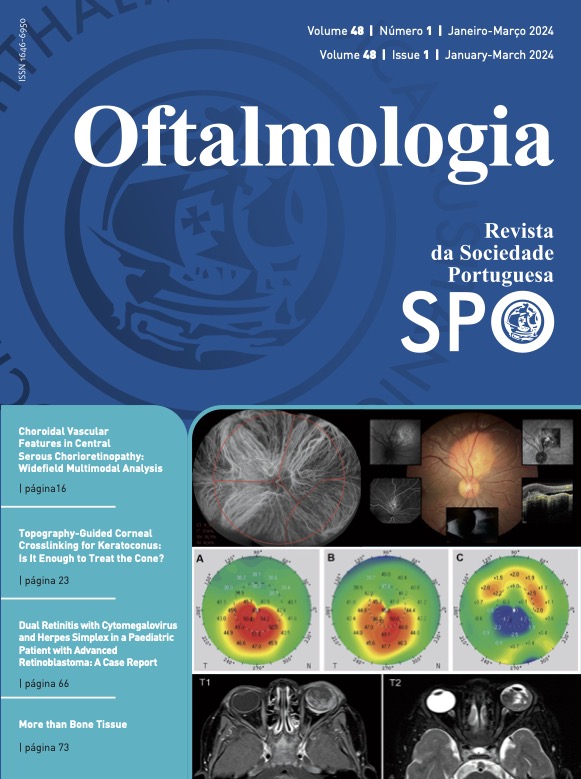Manifestações Oculares da Síndrome de Alport: Casuística de um Centro Hospitalar Português
DOI:
https://doi.org/10.48560/rspo.28276Palavras-chave:
Doenças da Retina, Nefrite Hereditária, Tomografia de Coerência ÓticaResumo
INTRODUÇÃO: A síndrome de Alport (SA) é uma doença hereditária que ocorre por variantes nos genes COL4A3/4/5. Padrões de hereditariedade incluem ligado ao X (SALX), autossómica dominante (SAAD) ou recessiva (SAAR) e digénica. As alterações do colagénio tipo IV α3α4α5 podem comprometer a estrutura da membrana basal do rim, cóclea e olho. As manifestações oculares incluem erosões corneanas recorrentes, lenticone, retinopatia dot-and-fleck e redução da espessura retinana temporal; apesar de raramente afetarem a visão, a sua deteção pode ajudar no diagnóstico. Neste trabalho são descritas as manifestações oculares de doentes com SA do Centro Hospitalar de Vila Nova de Gaia/Espinho.MÉTODOS: Estudo observacional transversal de 38 doentes com SA referenciados da consulta de Nefrologia. Todos realizaram avaliação oftalmológica completa com retinografia, tomografia de coerência ótica de domínio espectral (SD-OCT) da retina e microscopia especular (ME). Foram descritos os principais achados na avaliação oftalmológica, retinografia, ME e SD-OCT. Foi também determinada a espessura das camadas retinianas e o índice de espessura nasal/temporal (IAT – índice atenuação temporal), que foram comparados com um grupo controlo com emparelhamento 1:1.
RESULTADOS: Os doentes com SA tinham uma idade média de 49 anos, 53% eram do sexo feminino e 81% apresentavam variantes do gene COL4A3, maioritariamente SAAD. Não foram detetadas alterações corneanas ou lenticone; 4 doentes SAAD apresentavam retinopatia dot-and-fleck e 1 doente com variante digénica apresentava diminuição focal da espessura retiniana temporal. Na avaliação com SD-OCT não foi identificado um padrão específico de redução da espessura retiniana, e não existiam alterações no IAT comparativamente ao grupo controlo. A densidade média de células endoteliais era 2717 cels/mm2, com área média de 374 µm2; o coeficiente de variação e percentagem de células hexagonais era 32% e 58%, respetivamente, com espessura central de córnea de 538 µm.
CONCLUSÃO: Alterações oculares relacionadas com SA são raramente descritas no SAAD, que têm variantes em heterozigotia do gene COL4A3/4. Neste estudo 4 doentes com SAAD apresentavam retinopatia dot-and-fleck. Isto contrapõe-se à evidência atual de não-ocorrência de alterações oculares típicas no SAAD, pelo que uma avaliação oftalmológica em todos doentes com SA pode evidenciar informação diagnóstica.
Downloads
Referências
Alport AC. Hereditary familial congenital haemorrhagic nephritis. Br Med J. 1927;1:504-6.
Savige J, Gregory M, Gross O, Kashtan C, Ding J, Flinter F. Expert guidelines for the management of Alport syndrome and thin basement membrane nephropathy. J Am Soc Nephrol. 2013;24: 364-75.
Hasstedt SJ, Atkin CL.X-linked inheritance of Alport syndrome: family P revisited. Am J Hum Genet. 1983;35:1241-51.
Pajari H, Kääriäinen H, Muhonen T, Koskimies O. Alport’s syndrome in 78 patients: epidemiological and clinical study. Acta Paediatr. 1996;85:1300-6.
Kabosova A, Azar DT, Bannikov GA, Campbell KP, Durbeej M, Ghohestani RF, et al. Compositional differences between infant and adult human corneal basement membranes. Invest Ophthalmol Vis Sci. 2007;48:4989-99.
Larangeiro J, Sá MJ, Oliveira JP, Moura CP, Santos M. Perfil audiométrico em homens com síndrome de Alport; Rev Port Otorrinolaringol Cir Cabeça Pescoço. 1970;51:95-100.
Savige J, Liu J, DeBuc DC, Handa JT, Hageman GS, Wang YY, et al. Retinal basement membrane abnormalities and the retinopathy of Alport syndrome. Invest Ophthalmol Vis Sci. 2010;51:1621-7.
Arnott EJ, Crawfurd MD, Toghill PJ. Anterior lenticonus and Alport’s syndrome. Br J Ophthalmol. 1966;50:390-403.
Rahman W, Banerjee S. Giant macular hole in Alport syndrome. Can J Ophthalmol. 2007;42:314-5.
Savige J, Sheth S, Leys A, Nicholson A, Mack HG, Colville D. Ocular features in Alport syndrome: pathogenesis and clinical significance. Clin J Am Soc Nephrol. 2015;10:703-9. doi: 10.2215/CJN.10581014.
Savige J, Wang Y, Crawford A, Smith J, Symons A, Mack H, et al. Bull’s eye and pigment maculopathy are further retinal manifestations of an abnormal Bruch’s membrane in Alport syndrome. Ophthalmic Genet. 2017;38:238-44. doi: 10.1080/13816810.2016.1210648.
Shaw EA, Colville D, Wang YY, Zhang KW, Dagher H, Fassett R, et al. Characterization of the peripheral retinopathy in X-linked and autosomal recessive Alport syndrome. Nephrol Dial Transplant. 2007;22:104-8. doi: 10.1093/ndt/gfl607.
Colville D, Wang YY, Jamieson R, Collins F, Hood J, Savige J. Absence of ocular manifestations in autosomal dominant Alport syndrome associated with haematological abnormalties. Ophthalmic Genet. 2000;21:217-25.
Furlano M, Martínez V, Pybus M, Arce Y, Crespí J, Venegas MdP, et al. Clinical and genetic features of autosomal dominant Alport syndrome: A Cohort Study. Am J Kidney Dis. 2021;78:560-70.e1. doi: 10.1053/j.ajkd.2021.02.326.
Grading diabetic retinopathy from stereoscopic color fundus photographs--an extension of the modified Airlie House classification. ETDRS report number 10. Early Treatment Diabetic Retinopathy Study Research Group. Ophthalmology; 1991;98:786-806.
Ahmed F, Kamae KK, Jones DJ, Deangelis MM, Hageman GS, Gregory MC, et al. Temporal macular thinning associated with X-linked Alport syndrome. JAMA Ophthalmol. 2013;131:777-82. doi: 10.1001/jamaophthalmol.2013.1452.
Duman R, Tok Çevik M, Görkem Çevik S, Duman R, Perente İ. Corneal endothelial cell density in healthy Caucasian population; Saudi J Ophthalmol. 2016;30:236-9. doi: 10.1016/j.sjopt.2016.10.003.
Leung JC. Inherited renal diseases. Curr Pediatr Rev. 2014;10:95-100. doi: 10.2174/157339631002140513101755.
Matthaiou A, Poulli T, Deltas C. Prevalence of clinical, pathological and molecular features of glomerular basement membrane nephropathy caused by COL4A3 or COL4A4 mutations: a systematic review. Clin Kidney J. 2020;13:1025-36. doi: 10.1093/ckj/sfz176.
Gibson J, Fieldhouse R, Chan MMY, Sadeghi-Alavijeh O, Burnett L, Izzi V, et al. Prevalence Estimates of Predicted Pathogenic COL4A3-COL4A5 Variants in a Population Sequencing Database and Their Implications for Alport Syndrome. J Am Soc Nephrol. 2021;32:2273-90. doi: 10.1681/ASN.2020071065.
Nabais Sá MJ, Sampaio S, Oliveira A, Alves S, Moura CP, Silva SE, et al. Collagen type IV-related nephropathies in Portugal: pathogenic COL4A5 mutations and clinical characterization of 22 families. Clin Genet. 2015;88:462-7.
Nabais Sá MJ, Storey H, Flinter F, Nagel M, Sampaio S, Castro R, et al. Collagen type IV-related nephropathies in Portugal: pathogenic COL4A3 and COL4A4 mutations and clinical characterization of 25 families. Clin Genet. 2015;88:456-61.
Nozu K, Nakanishi K, Abe Y, Udagawa T, Okada S, Okamoto T, et al. A review of clinical characteristics and genetic backgrounds in Alport syndrome. Clin Exp Nephrol. 2019;23:158-68. doi: 10.1007/s10157-018-1629-4.
Sá MJ. Alport Syndrome: Clinical and molecular study of Portuguese families. [accessed Jan 2022] Available from: https://repositorio-aberto.up.pt/handle/10216/84789; 2014;
Jais JP, Knebelmann B, Giatras I, De Marchi M, Rizzoni G, Renieri A, et al. X-linked Alport syndrome: natural history and genotype-phenotype correlations in girls and women belonging to 195 families: a “European Community Alport Syndrome Concerted Action” study. J Am Soc Nephrol. 2003;14:2603-10.
Jais JP, Knebelmann B, Giatras I, Marchi M, Rizzoni G, Renieri A, et al.X-linked Alport syndrome: natural history in 195 families and genotype-phenotype correlations in males. J Am Soc Nephrol. 2000;11:649-57.
Usui T, Ichibe M, Hasegawa S, Miki A, Baba E, Tanimoto N, et al.Symmetrical reduced retinal thickness in a patient with Alport syndrome. Retina; 2004;24:977-9.
Adyeke SK, Ture G, Mutlubaş F, Aytoğan H, Vural O, Uzak- gider NK, et al.Increased subfoveal choroidal thickness and retinal structure changes on optical coherence tomography in pediatric Alport syndrome patients. J Ophthalmol. 2019;2019:6741930. doi: 10.1155/2019/6741930.
Bloch E, Clarke KM, Shalchi Z, Shunmugam M, Storey H, Hammond CJ, et al.Macular subfield thickness measurements in Alport syndrome. Invest Ophthalmol Visual Sci. 2021;62: 2460.
Chen Y, Colville D, Ierino F, Symons A, Savige J.Temporal retinal thinning and the diagnosis of Alport syndrome and Thin basement membrane nephropathy. Ophthalmic Genet. 2018;39:208-14. doi: 10.1080/13816810.2017.1401088.
Teekhasaenee C, Nimmanit S, Wutthiphan S, Vareesangthip K, Laohapand T, Malasitr P, et al. Posterior polymorphous dystrophy and Alport syndrome. Ophthalmology. 1991;98:1207-15.
Bower KS, Edwards JD, Wagner ME, Ward TP, Hidayat A.Novel corneal phenotype in a patient with alport syndrome. Cornea.2009;28:599-606.
Sabates R, Krachmer JH, Weingeist TA.Ocular findings in Alport’s syndrome. Ophthalmologica; 1983;186:204-10.
Seymenoğlu G, Baser EF.Ocular manifestations and surgical results in patients with Alport syndrome. J Cataract Refract Surg. 2009;35:1302-6.
Xu JM, Zhang SS, Zhang Q, Zhou YM, Zhu CH, Ge J, et al.Ocular manifestations of Alport syndrome. Int J Ophthalmol. 2010;3:149-51.
Nicklason E, Mack H, Beltz J, Jacob J, Farahani M, Colville D, Savige J. Corneal endothelial cell abnormalities in X-linked Alport syndrome. Ophthalmic Genet. 2020;41:13-9. doi: 10.1080/13816810.2019.1709126.
Downloads
Publicado
Como Citar
Edição
Secção
Licença
Direitos de Autor (c) 2024 Revista Sociedade Portuguesa de Oftalmologia

Este trabalho encontra-se publicado com a Creative Commons Atribuição-NãoComercial 4.0.
Não se esqueça de fazer o download do ficheiro da Declaração de Responsabilidade Autoral e Autorização para Publicação e de Conflito de Interesses
O artigo apenas poderá ser submetido com esse dois documentos.
Para obter o ficheiro da Declaração de Responsabilidade Autoral, clique aqui
Para obter o ficheiro de Conflito de Interesses, clique aqui





